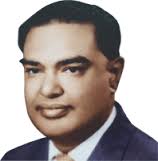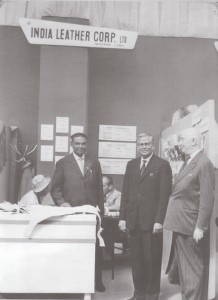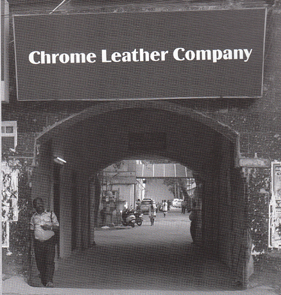Registered with the Registrar of Newspapers for India under R.N.I 53640/91
Vol. XXV No. 11, September 16-30, 2015
The Leather King
The book* is a fitting celebration of the legacy of A. Nagappa Chettiar, a pioneer of the leather industry in India.
Nagappa Chettiar, it is surprising to find, was not even a matriculate and “spoke haltingly in English”, to quote retired IAS officer Dr. G. Sundaram, and yet was a trailblazer of the leather industry. The distinct look of Chettiar, always clad in white shirt and white dhoti, even in the presence of suited-and-booted foreign visitors, subtly speaks of his conviction to stick to his roots.
Born in Melsivapuri in Pudukottai district on August 6, 1915, Nagappan lost his father very early. As was usual with Nattukottai Chettiars, he joined the banking business of M. Narayanan Chettiar in Ceylon, when he was just 15. In 1937, he launched out on his own into leather trading. A tannery was operated from rented premises in 1938. The leather industry was in a nascent stage in Ceylon at the time and Nagappa Chettiar and his partner adopted a scientific method of processing leather using vegetable tanning with wattle bark extract to save cost and time. Building on quality and timely delivery, the firm created an export market demand for its products. The rise of his business was meteoric and, by 1943, a new tannery was built in Himbutuwelgoda near Colombo. During World War II, his firm supplied raw material to be used in boots for the Army.

A. Nagappa Chettiar..
Acting on the suggestion of the then Indian Agent in Ceylon, M.S. Aney, to set up operations in India considering the future political scenarios, Nagappa Chettiar, along with other directors, established an agency, Palaniappa Chettiar & Co. in Madras and also tanneries in Pallavaram and Dindugal.

Nagappa Chettiar with R. Venkataraman at ILC Stall, Paris..
At that time, East India tanned hides and skins (known as EI tanned leathers), produced through tanning using vegetable materials and indigenous barks and, later, wattle extract, were in high demand by the British for export to the UK from India. After Independence, sensing that the demand for tanned leather from India would grow considerably, Nagappa Chettiar along with other directors from his community established the India Leather Corporation Private Limited (ILC) in 1948. Under this company’s name, many tanneries under the independent management of its directors were established in Salem, Pallavaram, Vellore, Trichy, Madhavaram and Red Hills near Madras and Gudiyatham. ILC also bought a transport company in Bangalore to meet its transportation needs.
The first major breakthrough that Nagappa Chettiar, as Managing Director of ILC, achieved was convincing the Japanese to buy higher grade of leather in place of their low grade imports. This was during his visit to Japan in 1953. As a result, ILC was supplying one-third of all Japanese leather needs in the 1950s. He also visited the UK and Europe to establish direct contact with buyers. Buyers in Europe were getting their leather through auctions in the UK. What Nagappa Chettiar did changed the fortunes of the leather industry in India. Instead of going through the auction system, he directly reached out to the buyers. ILC’s exports exceeded Rs. 2.5 crores by 1957 and ILC became the largest single foreign exchange earner in the Southern Region in the 1950s.
As export market demand for leather increased, ILC moved into its own building in 1958, the India Leather Mansion at Davidson Street. The office also housed an electric baling press, electric hoists, a testing laboratory, an exhibition of products of EI tanned leather, a technical library and a canteen. Nagappa Chettiar appointed agents for ILC in France, Belgium, Italy, Germany, USA and Japan. ILC offices were opened in London, Paris, Milan, Madrid, Frankfurt, New York and Tokyo. The company’s activities also expanded beyond Madras state into Colombo, Calcutta and Cuddapah. He was hailed as the ‘Leather King’ by his customers abroad.
Next, in a bold move, ILC in 1965 bought the ailing Chrome Leather Company (CLC), which had a large estate and an integrated leather centre. This company of repute had been started by the British and was being managed by Ida Chambers, an Australian and a member of the founding family. He turned around the company, but due to Reserve Bank of India’s policies, lines of credit for the company began to expire by 1972. Nagappa Chettiar nevertheless sustained the company.

A historic institution Nagappa Chettiar acquired..
Nagappa Chettiar was closely associated with the Central Leather Research Institute since its inception in 1948. He was Chairman of the Institute’s Governing Council and also a member of the research council at various time periods. He enjoyed a good rapport with its illustrious director, Dr. Y. Nayudamma, in the 1960s, and the directors who followed him. His lasting contributions to the Institute are visible even today. It was he who mooted the idea of International Leather Fair in Madras and was successful in organising the first fair at the CLRI premises in 1964 with able support from Nayudamma. The Tanners’ Get-Together, which started at the fair, has become the Leather Industry Get-Together (LERIG) from 1991. The international fair and fashion show, which is a part of the fair, has since 1986 been organised by Indian Trade Promotion Organisation (ITPO), Government of India.
Chettiar donated Rs. 51,000 to set up the Footwear Research Centre inside the CLRI campus in 1972. It has morphed into the shoe Design and Development Centre (SDDC) today and undertakes consultancy services to the industry. He also donated Rs. 1 lakh to set up a Leather Museum inside the CLRI campus. Although the building is complete, it is yet to see the ideal of Nagappa Chettiar fulfilled. But it is fitting that his statue was installed in the Institute’s premises near the museum in 1988.
His significant contribution to the leather industry is changing the paradigm from exporting wet skins and hides of lower quality and semi-finished leather into fully finished leather and value-added leather products to other countries. His collaboration with academia enabled him to look for innovative ways to improve the quality of leather. He was awarded Padma Shri by Government of India in 1967 for his contributions to the leather industry.
Apart from product innovation, Nagappa Chettiar was also instrumental in bringing the leather industry together. He, along with his colleagues in the industry, persuaded the Government of India to institute a Leather Export Promotion Council (LEPC) which took shape in 1956 at Marble Hall in Periamet, Madras. Dr. G. Sundaram, IAS, was Secretary of LEPC from 1971 to 1974. He pays handsome tribute to Nagappa Chettiar who was Chairman of LEPC at that time, pointing out that Chettiar had a sharp mind despite lack of formal education. Many important changes took place when the Chettiar-Sundaram combine encouraged switching from semi-finished leather to finished leather for export. Necessary clearances for acquiring machinery were also streamlined.
Despite his towering achievements, Chettiar remained humble. Always clad in khadi an a true Gandhian, he always recalled Mahatma Gandhi’s lament in The Harijan as early as 1934 – that hides worth Rs. 9 crore exported from the country returned as manufactured articles, representing a material as well as intellectual drain. This inspired Chettiar to look for ways to improve the situation. He donated liberally to educational causes and also to temples.
A postcard from Buenos Aires to his daughter (addressed as Miss Yegu Nagappan) in 1961, featured in the book, reveals his concern for her and his wife from far afar when instant communication was star years away. In the Foreword to the book, Yegammai says his father always found time for the family despite his pressing business interests. This pioneer of leather trade in India breathed his last in 1982, aged 67. His death was a great loss to ear industry in particular.
K. Venkatesh
* J. Prasad Davids, Leather King Padma Shri A. Nagappa Chettiar: Inspiring Legacy of His Success – in Management, Public and Personal Life, Nagappan Foundation, Chennai, 2015.

